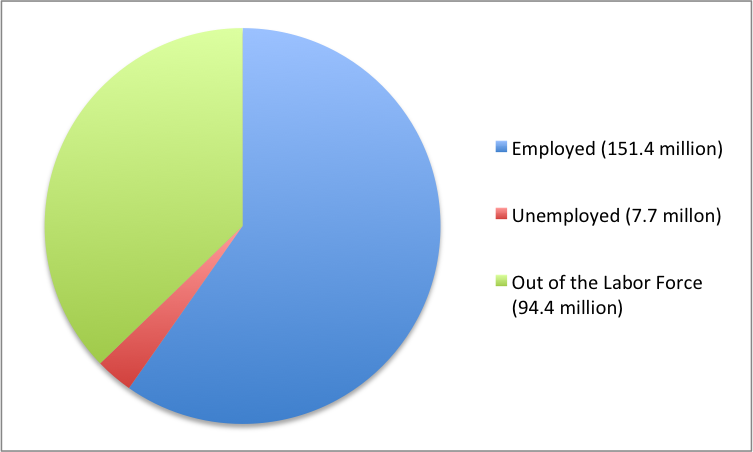7.10: Who Counts in Unemployment?
- Page ID
- 47370
Learning Objectives
- Define and differentiate between employed, unemployed, and being in or out of the labor force
The Cost of Unemployment
Unemployment can be a terrible and wrenching life experience—like a serious automobile accident or a messy divorce—whose consequences can be fully understood only by someone who has gone through it. For unemployed individuals and their families, there is the day-to-day financial stress of not knowing where the next paycheck is coming from. There are painful adjustments, like watching your savings account dwindle, selling a car and buying a cheaper one, or moving to a less expensive place to live. Even when the unemployed person finds a new job, it may pay less than the previous one. For many people, their job is an important part of their self worth. When unemployment separates people from the workforce, it can affect family relationships as well as mental and physical health.
The human costs of unemployment alone would justify making a low level of unemployment an important public policy priority. But unemployment also includes economic costs to the broader society. When millions of unemployed but willing workers cannot find jobs, an economic resource is going unused. An economy with high unemployment is like a company operating with a functional but unused factory. The opportunity cost of unemployment is the output that could have been produced by the unemployed workers.
Calculating Unemployment
Unemployment is typically described in newspaper or television reports as a percentage or a rate. A report might say, for example, from January 2013 to December 2013, the U.S. unemployment rate dropped from 8.0% to 6.7%, and by the close of 2015, it had fallen to 5.0%. At a glance, the changes between the percentages may seem small. But remember that the U.S. economy has over 160 million adults who either have jobs or are looking for them. A rise or fall of just 0.1% in the unemployment rate of 160 million potential workers translates into 160,000 people, which is roughly the total population of a city like Syracuse, New York, Brownsville, Texas, or Pasadena, California. Large rises in the unemployment rate mean large numbers of job losses. The decrease in unemployment from 8% in 6.7% 2013 meant an additional 2.02 million people were employed who had previously been looking for work.
Link It Up
The Bureau of Labor Statistics tracks and reports all data related to unemployment.
Who’s In or Out of the Labor Force?
Should everyone without a job be counted as unemployed? Of course not. Children, for example, should not be counted as unemployed. Surely, the retired should not be counted as unemployed. Many full-time college students have only a part-time job, or no job at all, but it seems inappropriate to count them as suffering the pains of unemployment. Some people are not working because they are rearing children, ill, on vacation, or on parental leave.
watch It
Learn about what constitutes the labor force in this short video:
An interactive or media element has been excluded from this version of the text. You can view it online here: http://pb.libretexts.org/mlum/?p=300
The point is that the adult population is not just divided into employed and unemployed. A third group exists: people who do not have a job, and for some reason—retirement, looking after children, taking a voluntary break before a new job—are not interested in having a job, either. It also includes those who do want a job but have quit looking, often due to being discouraged by their inability to find suitable employment. Economists refer to this third group of those who are not working and not looking for work as out of the labor force.

The U.S. unemployment rate, which is based on a monthly survey carried out by the U.S. Bureau of the Census, asks a series of questions to divide up the adult population into employed, unemployed, or not in the labor force. To be classified as unemployed, a person must be without a job, currently available to work, and actively looking for work in the previous four weeks. Thus, a person who does not have a job but who is not currently available to work or has not actively looked for work in the last four weeks is counted as out of the labor force.
- Employed: currently working for pay
- Unemployed: Out of work and actively looking for a job
- Out of the labor force: Out of paid workforce and/or not actively looking for a job
- Labor force: the number of employed plus the unemployed
Glossary
[glossary-page][glossary-term]discouraged workers: [/glossary-term]
[glossary-definition]those who have stopped looking for employment due to the lack of suitable positions available[/glossary-definition]
[glossary-term]out of the labor force: [/glossary-term]
[glossary-definition]those who are not working and not looking for work—whether they want employment or not; also termed “not in the labor force”[/glossary-definition][glossary-term]underemployed: [/glossary-term][glossary-definition]individuals who are employed in a job that is below their skills[/glossary-definition][/glossary-page]
- Modification, adaptation, and original content. Provided by: Lumen Learning. License: CC BY: Attribution
- How Economists Define and Compute Unemployment Rate. Authored by: OpenStax College. Provided by: Rice University. Located at: https://cnx.org/contents/vEmOH-_p@4.44:rrKevL6Q/How-Economists-Define-and-Comp. License: CC BY: Attribution. License Terms: Download for free at http://cnx.org/contents/bc498e1f-efe...69ad09a82@4.44
- (Macro) Episode 18: Unemployment. Authored by: Dr. Mary McGlasson. Located at: https://www.youtube.com/watch?v=_CdTu1pk06w&index=18&list=PLF2A3693D8481F442. License: CC BY-NC-ND: Attribution-NonCommercial-NoDerivatives

